

The ideal book or book beautiful, a tract on calligraphy, printing, and illustration & on the book beautiful as a whole.
1. The complaint, and the consolation; or, Night thoughts
2. The Fables of Æesop, and others / With designs on wood, by Thomas Bewick
5. News from nowhere: or, An epoch of rest, being some chapters from Utopian romance
6. The nature of Gothic, a chapter of the stones of Venice
7. Daphnis and Chloe: a most sweet abd pleasant pastoral romance for young ladies
8. The Sphinx
10. Credo
14. Bible.Old Testament. Song of Solomon.
16. Kem byt’? / V. Mai︠a︡kovskiĭ ; ris. N. Shifrin.
17. The ghost in the underblows
19. Bateau ivre
UCLA Call Number: Press Coll. Doves Annex
The ideal book or book beautiful, a tract on calligraphy, printing, and illustration & on the book beautiful as a whole
The ideal book or book beautiful, a tract on calligraphy, printing, and illustration & on the book beautiful as a whole
The ideal book or book beautiful, a tract on calligraphy, printing, and illustration & on the book beautiful as a whole
The ideal book or book beautiful, a tract on calligraphy, printing, and illustration & on the book beautiful as a whole
The ideal book or book beautiful, a tract on calligraphy, printing, and illustration & on the book beautiful as a whole
The ideal book or book beautiful, a tract on calligraphy, printing, and illustration & on the book beautiful as a whole
-->
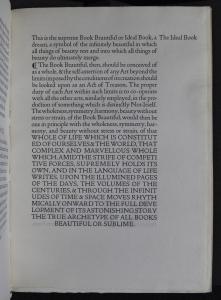
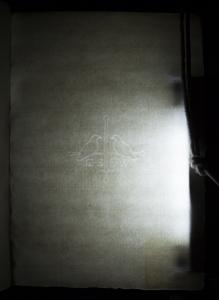
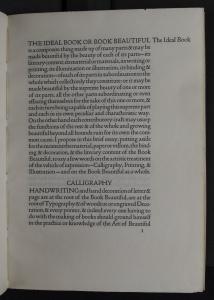
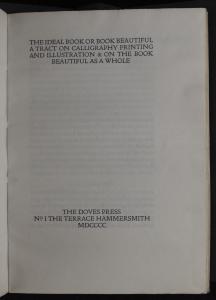

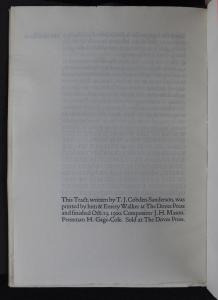
Full title
Creator: Cobden–Sanderson,T.J. (Thomas James)
Publisher: Doves Press
Publication Place: Hammersmith
Date of Publication: 1900
Dimensions 23.5 cm
Physical Description:
Bound in white vellum. The pages are roughly and unevenly cut, appearing almost torn, but are not sufficiently uniform to be called deckled. The pages (and the book as a whole) are very rugged compared to Cobden–Sanderson’s 1908 Credo. The string binding is visible and the vellum cover is flexible and gives to crinkling. “THE DOVES BINDERY” is stamped onto the bottom border of the back cover. The Doves Press watermark appears faintly on the inside front cover.
Provenance: Unknown.Condition:
This copy is in fair condition. The vellum covers (front and back) are bent and warped. The interior pages are also slightly warped from age and exposure. The front of the first page bears dark brown staining from the Clark Library sticker directly opposite on the front interior cover. That stain has actually pushed through several more pages, each fainter than the previous.
Additional Info:
Both content and execution make this an excellent tool for teaching the tenets of the Arts & Crafts movement. Can also be used as an example of vellum binding and modern typeface. Altogether, this book feels much more “crafted” and unpolished than the 1908 Credo. The paper is thinner, lighter and less dense (thus, more fragile). The page before the title page bears a mysterious single lowercase “a” printed in black ink toward the bottom of the page. A single lowercase “b” appears just below the bottom line of text on p. 5.
Interpretation:
In his 1893 preface to a collection of essays by members of the Arts and Crafts Exhibition Society, William Morris argued that the “lack of beauty in modern life…which in the earlier part of the century was unnoticed, is now recognized by a part of the public as an evil to be remedied if possible.” This is the broadest statement of the Society’s objective, which its members–with Morris at the forefront–sought to achieve by cultivating the arts through a variety of manual crafts. No matter the medium, the goal was uniform. It comes as no surprise, then, that Morris founded his Kelmscott Press and began printing books with the express “hope of producing some which would have a definite claim to beauty” (Morris, The Art and Craft of Printing).
Similarly for T.J. Cobden–Sanderson, the book was of keen interest as an outlet for creating and offering beauty to a society that was, as he and the larger movement believed, increasingly bereft of it. He saw bookbinding as just one of many possible outlets for honing and exhibiting the possibilities of manual craftsmanship–the cornerstone of the Arts & Crafts movement’s social agenda. Echoing Morris, he wrote to Emily Preston in 1902 that “the cause is not book–binding, nor a handicraft, nor a pattern, nor getting a living, but that sound view of life as a whole, which shall make all other sound things possible, and among the sound things, some that may be beautiful. Book-binding is but the illustration.”
Completed at the height of the Arts & Crafts movement in 1900, Cobden-Sanderson’s The Ideal Book opens by further magnifying the very same pivotal point: the “Book Beautiful,” as an object, is to be understood as a thing &ldqou;made up of many parts” and “made beautiful by the beauty of each of its parts–its literary content, its material or materials, its writing or printing, its illumination or illustration, its binding and decoration–in subordination to the whole which collectively they constitute.” So it is that this brief essay defines and exemplifies its author’s philosophy for advancing the movement’s cause by honing specific sets of skills. The Ideal Book argues that the book is a “vehicle of expression” –that no individual artistic element of bookbinding should overwhelm or usurp the beauty of the whole. As he explains the ideal use and appearance of elements ranging from illustration to calligraphy, he posits that the real significance of each individual craft required to construct a book is constituted by its role in perfecting the final product. Likewise, as Cobden–Sanderson explained to Preston, the value of the book as a whole–composed itself of individual crafts–is constituted by its existence as material evidence of the creation of art.
Furthermore,The Ideal Book, as an object, remains wonderfully representative of this main tenet of the Arts & Crafts movement while proposing an aesthetic vision of the “Book Beautiful” that politely diverges from the one espoused by William Morris. Like other works by Cobden–Sanderson and the Doves Press,The Ideal Book stands in stark contrast to Morris’ most ambitious creations. Where Morris embellished his Kelmscott pages with thick, intricate ornamentation and bold, typically tactile type, the Doves Press favored a more delicate final product–which we see in The Ideal Book’s unadorned white pages and signature modern font.The Ideal Book is a valuable addition to this collection because it helps to broaden our conception of the Arts & Crafts movement by demonstrating–in its content and as an object–that there were many unique individual perspectives and technical approaches working in service of the same core values.
Text Content Description:
The text consists of a brief essay in which Cobden–Sanderson describes the ideal implementation of certain artistic techniques in bookmaking and printing. It opens with a short introduction outlining the author’s Arts & Crafts philosophy and the role of the book and bookbinding in realizing that philosophy. He then devotes sections to Calligraphy, Typography and Illustration, detailing his thoughts on the proper aesthetic use and value of each.
Contributor: Margarita Howell